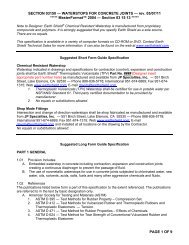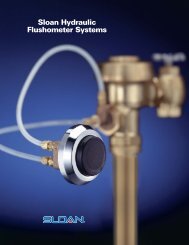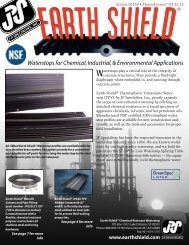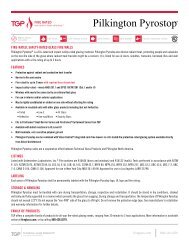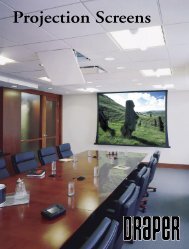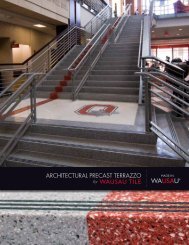National Gypsum Construction Guide
National Gypsum Construction Guide The entire - AECinfo.com
National Gypsum Construction Guide The entire - AECinfo.com
- No tags were found...
You also want an ePaper? Increase the reach of your titles
YUMPU automatically turns print PDFs into web optimized ePapers that Google loves.
INTERIOR APPLICATIONS<br />
APPLICATIONS<br />
An ideal underlayment for<br />
interior applications such as:<br />
Shower and tub enclosures<br />
Garden/whirlpool tubs<br />
Countertops<br />
Backsplashes<br />
Steamrooms and saunas<br />
Swimming pool and<br />
whirlpool decks<br />
Floor underlayment<br />
– Entryways<br />
– Kitchens<br />
– Bathrooms<br />
– Foyers<br />
– Laundry rooms<br />
TUB & SHOWER SURROUND<br />
INSTALLATION<br />
General: All framing should<br />
comply with local building<br />
code requirements and be<br />
designed to provide support<br />
with a maximum allowable<br />
deflection of L/360 under<br />
all intended loads. Framing<br />
members should be spaced<br />
a maximum of 16" o.c.<br />
Note: Cut or score<br />
PermaBase on rough side<br />
of panel. Install tile and<br />
tile setting materials in<br />
accordance with current<br />
ANSI specifications and<br />
Tile Council of America<br />
(TCA) guidelines.<br />
Control Joints: For interior<br />
installations, allow a<br />
maximum of 30 lineal feet<br />
between control joints. A<br />
control joint must be<br />
installed but not limited to<br />
the following locations:<br />
where expansion joints<br />
occur in the framing or<br />
building (discontinue all<br />
cross furring members<br />
located behind joint); when<br />
boards abut dissimilar<br />
materials; where framing<br />
material changes; at<br />
changes of building shape<br />
or structural system; at each<br />
story separation. Place<br />
control joints at corners of<br />
window and door openings,<br />
or follow specifications of<br />
architect. Control joint cavity<br />
shall not be filled with<br />
coating or other materials.<br />
146<br />
<strong>Gypsum</strong> Board<br />
2"x4" Wood Studs<br />
16" o.c.<br />
PermaBase<br />
Cement Board<br />
Tile<br />
Adhesive or<br />
Latex-Portland<br />
Cement Mortar<br />
<strong>Gypsum</strong> Board<br />
PERMABASE BRAND CEMENT BOARD<br />
WALLS & CEILINGS<br />
Wall Framing: Edges of<br />
PermaBase parallel to<br />
framing should be continuously<br />
supported. Provide<br />
additional blocking when<br />
necessary to permit proper<br />
PermaBase attachment.<br />
Do not install PermaBase directly<br />
over protrusions from stud<br />
plane such as heavy brackets<br />
and fastener heads. Studs<br />
above a shower floor should<br />
either be notched or furred to<br />
accommodate the thickness<br />
of the waterproof membrane<br />
or pan. The surround opening<br />
for a tub or precast shower<br />
receptor should not be more<br />
than 1/4" longer than unit to<br />
be installed.<br />
Ceiling Framing: The deflection<br />
of the complete ceiling<br />
assembly due to dead load<br />
(including insulation,<br />
PermaBase, bonding<br />
material and facing<br />
material) should not<br />
exceed L/360. The dead<br />
load applied to the ceiling<br />
frame should not exceed<br />
10 psf. Ceiling joist or<br />
furring channel should not<br />
exceed 16" o.c. (Edges of<br />
PermaBase parallel to<br />
framing should be continuously<br />
supported.) Provide<br />
Cement Board<br />
Screws, 8" o.c.<br />
Fiberglass<br />
Mesh Tape<br />
(Alkali Resistant)<br />
additional blocking when<br />
necessary to permit proper<br />
PermaBase attachment.<br />
PermaBase Cement Board:<br />
Apply PermaBase with ends<br />
and edges closely butted<br />
but not forced together.<br />
Stagger ends joints in<br />
successive courses. Drive<br />
fasteners into field of<br />
cement board first, working<br />
toward ends and edges.<br />
Space fasteners maximum<br />
8" o.c. for walls, 6" o.c. for<br />
ceilings with perimeter<br />
fasteners at least 3/8" and<br />
less than 5/8" from ends and<br />
edges. Ensure PermaBase is<br />
tight to framing.



